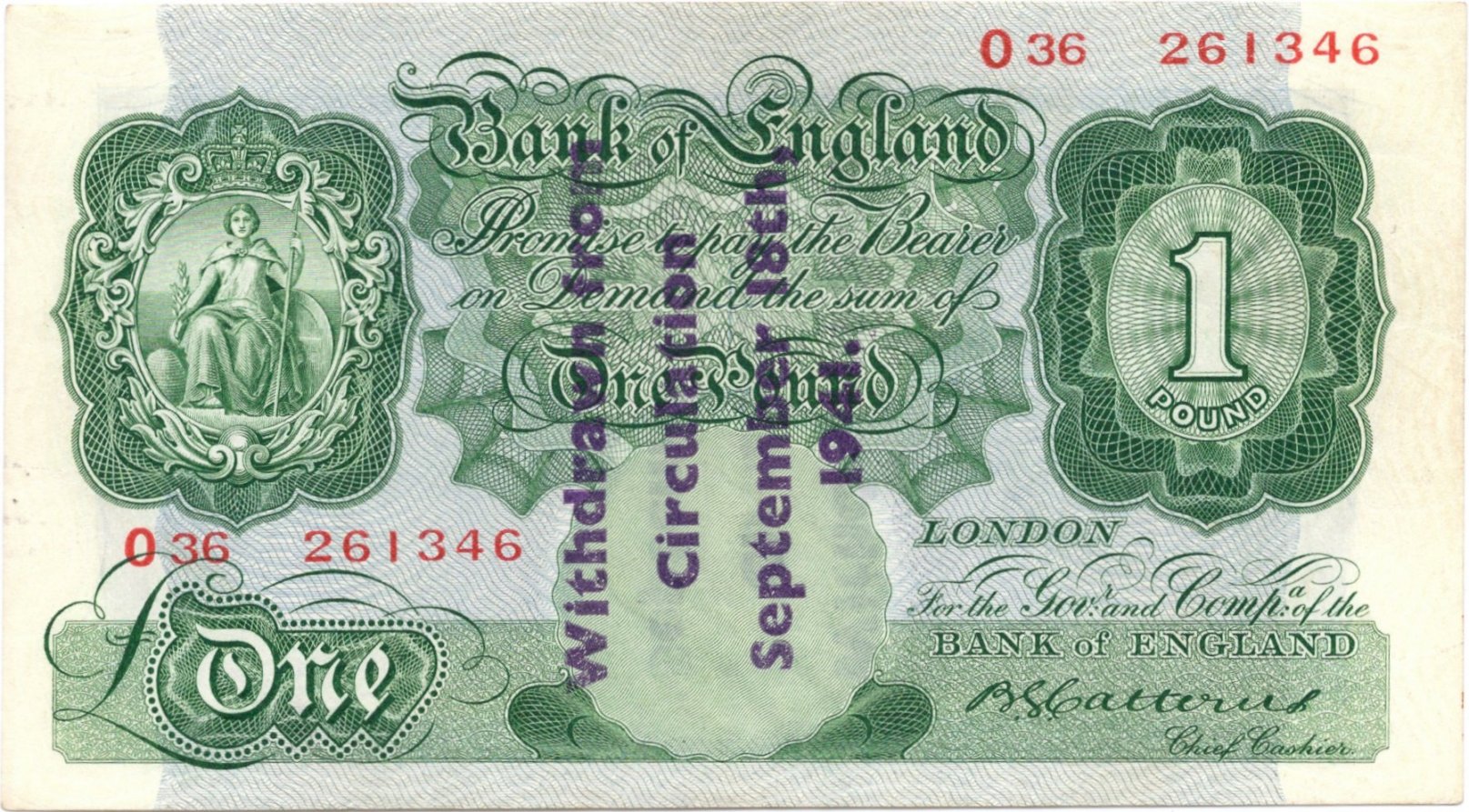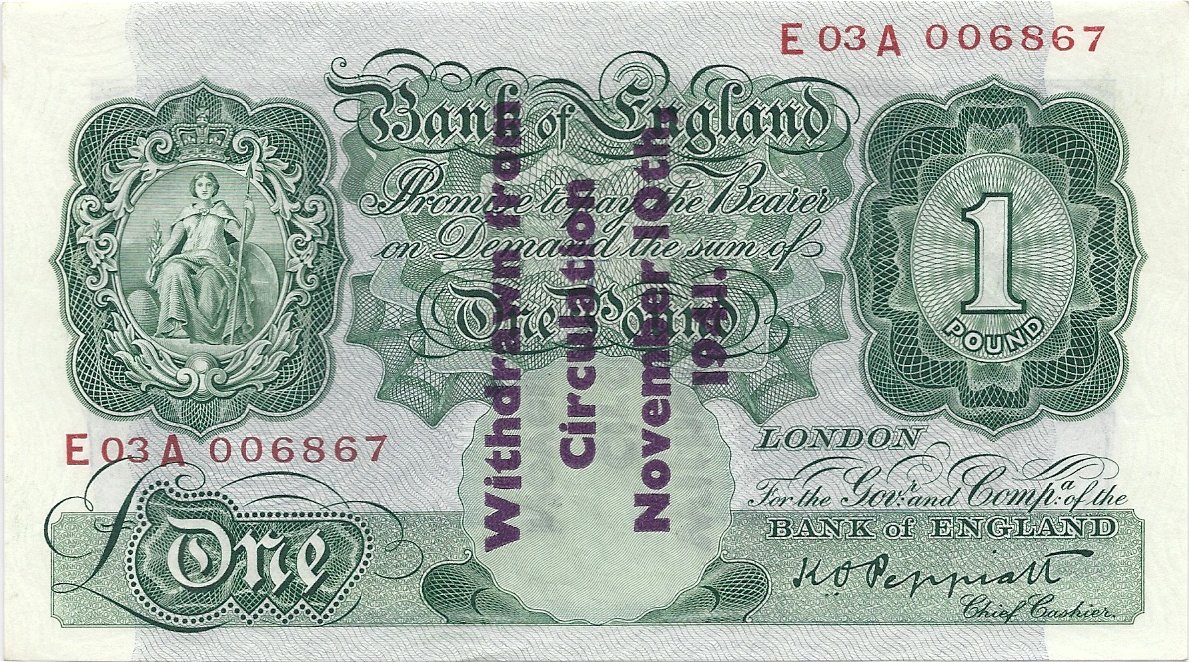The States of Guernsey Overprints
Guernsey Overprints
THE INTRIGUING TALE OF THE WARTIME GUERNSEY OVERPRINTS
Article written by Jonathan Callaway
The Second World War broke out in 1939 and after the fall of France in 1940 the only part of the British Isles to be invaded, the Channel Islands, were occupied by German forces. The Germans introduced their own currency, the hated Reichskreditkassenscheine military notes and coins, decreed it to be legal tender and insisted on its use. The existing Bank of England banknotes and, in Guernsey, locally issued £1 and 10 shillings notes, were initially allowed to continue in circulation but all Sterling banknotes and coins began to disappear into people’s bottom drawers. As a result an acute shortage of small change developed.
Therefore, in 1941, the States of Guernsey (the local civilian government) sought German permission to issue small notes to fill the gap. £5,000 worth was approved but only in exchange for depositing an equivalent amount of Guernsey notes with the Germans. The States selected the scruffiest £1 and 10 shillings notes they could find in their vaults, stamped them 'Withdrawn from Circulation' and handed them over. This was an accurate description as they had already been withdrawn for destruction due to their poor condition. Obviously with such an overprint they could not be re-used and were effectively worthless but the Germans nevertheless allowed the issue of small notes to go ahead. Guernsey then issued their famous and very collectible series of small notes, for 6d (i.e. six old pence or 2½ new pence), 1s3d (i.e. one old shilling and three pence or 6¼ new pence), 2s6d and 5s. The 1s3d denomination was found to be awkward to use and most of these notes were later overprinted and reissued as 1s notes. The 10s and £1 banknotes came later, being added in 1943.
It soon transpired that these small notes were not enough to fill the gap as they too were being hoarded by the cautious locals. So later in 1941 the States approached the Germans again and asked for permission to issue another £5,000 worth of small notes. This time the Germans demanded that they hand over an equivalent amount of Bank of England banknotes and the States had no choice but to comply, using notes taken from circulation or in local banks. These notes were also stamped 'Withdrawn from Circulation' with one of two dates added, either September 18th 1941 or November 10th 1941. This again had the effect of making them worthless but the notes were accepted by the Germans and the States went ahead with a further issue of small notes. The total small note issue, incidentally, exceeded the agreed limit and reached £11,767.
This is where the story gets interesting. Apparently all the Bank of England banknotes handed over were £1 banknotes (no 10 shillings banknotes even though these also circulated in Guernsey) and it has been stated that a full record of all the serial numbers was made by the States prior to doing so. The banknotes then presumably sat in a German safe for the duration of the war. When Liberation came to Guernsey and the other Channel Islands on 9th May 1945 the States swiftly carried out a carefully prepared plan to withdraw all German notes and coins and replace them with new local notes, already secretly printed and ready for issue.
Exactly what happened to the 5,000 overprinted Bank of England £1 banknotes at this point is not clear. The £5,000 worth of Guernsey’s own notes withdrawn and overprinted in 1941 were definitely returned by the Germans and it has been confirmed that they were all destroyed in 1945. The Germans should also have handed over the Bank of England banknotes but the record does not specify if and how that happened. The official list of serial numbers has never been found and some suggest it was never produced in the first place. The Bank of England itself apparently has no record of it.
One would also have expected the States, as soon as they got the Bank of England banknotes back, to have returned them to the Bank of England. This did not happen either and the fate of the banknotes in the immediate period after the war is shrouded in mystery. What now seems clear is that the 5,000 £1 banknotes did not go straight back to the States of Guernsey, rather they found their way to neighbouring Jersey. Soon after Liberation in 1945 some £2,000 worth were discovered there and returned to Guernsey although the circumstances of this discovery are also unclear. On receipt of the 2,000 £1 banknotes the States sent them back to the Bank of England for cancellation. It seems no list was made of these banknotes, nor were they checked against the original list, if indeed it had ever been made. One suspects they were simply counted and despatched.
But what happened to the balance of 3,000 £1 banknotes? These remained hidden until many years later when they were rediscovered in the early 1980s in the personal effects of a deceased antique dealer on Jersey. How did they end up there? The story goes that he had allegedly collaborated with the Germans during the war, had done some sort of black market deal with them and been paid with these banknotes. As there was no way for him to explain after the war how he had got them and he obviously could not spend them, they were just hidden away only for them later to be found by those settling his estate.
The lawyers handling the antique dealer’s estate decided to sell the banknotes en bloc and sought bids. While the sale was being arranged the banknotes were examined by two reputable researchers and collectors who assiduously photocopied the whole lot. The hoard totalled just under the full 3,000 banknotes because several had been sold locally over the years. Once the details of the hoard had been recorded and the sale to a large wholesale firm of dealers in New York completed, the banknotes were offered for sale to collectors. Most were sold in the US market but a number subsequently found their way back to the UK.
This story has been compiled in part from the reminiscences of people involved in the discovery and sale of the hoard, but other sources have provided helpful information too. However, it should come as no surprise that it has been impossible to corroborate all this from relevant official records so seekers after absolute certainty will remain disappointed. The fact that no Bank of England 10s banknotes were overprinted can be explained by the States wanting to minimise the effort in overprinting the banknotes. The fact that uncirculated as well as circulated banknotes were overprinted (unlike the soiled and worn Guernsey notes withdrawn and overprinted the first time the Germans demanded covering funds for the local note issue) can be explained by the need to act quickly and take whatever Bank of England banknotes were available in the banks or in circulation.
The story of how the Bank of England banknotes found their way from Guernsey to Jersey at the end of the war cannot be proved or disproved but the sequence of events set out above certainly seems credible. In summary, there is no hard evidence to undermine the belief that the hoard represents a significant part of the £5,000 of banknotes the States of Guernsey had to hand over to the German invaders in 1941.
The efforts of researchers and collectors some 30 years ago have enabled full details of the banknotes in the hoard to be recorded and a breakdown of the different varieties has been available for several years. The signatures and prefixes identified are consistent with what one might have expected to see in circulation in Guernsey when the invasion took place in 1940. The blue wartime emergency issue of the Bank of England £1 banknote had just been introduced in March 1940, a few months before the invasion in July of that year, so the appearance of a few of these banknotes in the hoard, some in sequence and in almost uncirculated condition, is also to be expected. The full breakdown appears at the end of this article and has been adjusted slightly from the figures previously published in English Paper Money by Vincent Duggleby and Pam West and in Token Publishing’s Banknote Year Book.
Warning: Forgeries
An unfortunate temptation has of course been created in that the market value of the overprinted notes is rather higher than that of the regular issues, significantly so for some of the rarer varieties. Forged overprints have therefore appeared from time to time and currently seem to be on the increase. They can be spotted in one of three possible ways:
1. The prefix does not match those in the summarised lists already published
2. All genuine overprints are in dark blue while the forged ones are in some cases in a lighter shade of blue or use black ink
3. The font used on the overprint does not conform to that used on the originals
It has also been observed that some forged overprints are not quite vertical and in some cases the ink has seeped through from one side of the note to the other.
An important caveat remains: if the prefix on an overprinted banknote does not conform this does not automatically mean it is a forgery. As mentioned earlier some banknotes had already found their way on to the market prior to the discovery of the hoard and these may quite legitimately carry a previously unrecorded prefix.
Updated checklist of prefixes and serials
Where new help should now be available to collectors lies in recent heroic efforts to transcribe the prefixes and serials of every one of the photocopied banknotes and post them on-line. This job was recently completed working from the original 130 pages of photocopies and by the time this article is published the full list should have been posted.
Minor counting errors have been identified in the totals previously published and the revised total is now 2,950 notes. Collectors will now be able to check any note offered to them to see if came from the original hoard – BUT do remember that if the banknote is not listed this does not automatically mean it is a forgery. The following advice therefore applies:
IMPORTANT: IF ANY COLLECTOR IS UNCERTAIN ABOUT A BANKNOTE BEING OFFERED HE OR SHE SHOULD CONTACT A REPUTABLE DEALER OR EXPERIENCED COLLECTOR TO HAVE THE BANKNOTE’S AUTHENTICITY CONFIRMED
UPDATED SUMMARY OF GUERNSEY OVERPRINTS ON BANK OF ENGLAND £1 NOTES
TYPE A – Overprint dated September 18th 1941, full stop after the year, front of the note only
Mahon Letter No No A-- to H-- (all 8 prefixes) 48 notes
Catterns Letter No No H-- to Z-- (all 15 prefixes) 69 notes
Catterns No No Letter --A only 5 notes
Peppiatt unthreaded No No Letter --B to --Z (all 19 prefixes) 328 notes
Peppiatt unthreaded Letter No No Letter A--A to L--A (all 9 prefixes) 1,903 notes
Peppiatt blue Letter No No Letter A--D 35 notes & C--D 93 notes
TYPE B – Overprint dated November 10th 1941, full stop after the year, both front and reverse
Peppiatt unthreaded Letter No No Letter E03A 80 notes
TYPE C – Overprint dated November 10th 1941, full stop after the year, reverse only
Peppiatt unthreaded Letter No No Letter E15A 398 notes
TOTAL 2,959
Acknowledgements
The author would like to thank all those who helped him prepare this article, in particular Claire Lobel, Simon Narbeth, Mark Ray and Pam West. Huge thanks are also due to Robin Hill and Pam and Pete West for having taken the time to transcribe details of every banknote in the hoard. Pam also provided all the illustrations.

B225A Catterns Genuine Overprint

B239B Peppiatt Genuine Overprint
